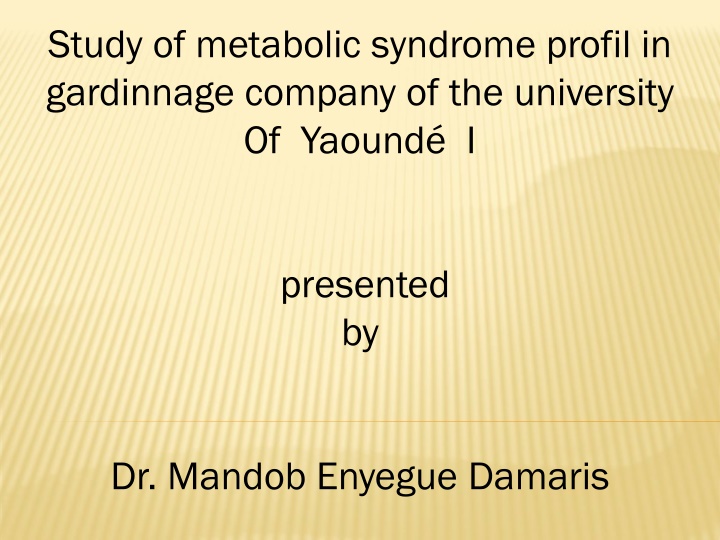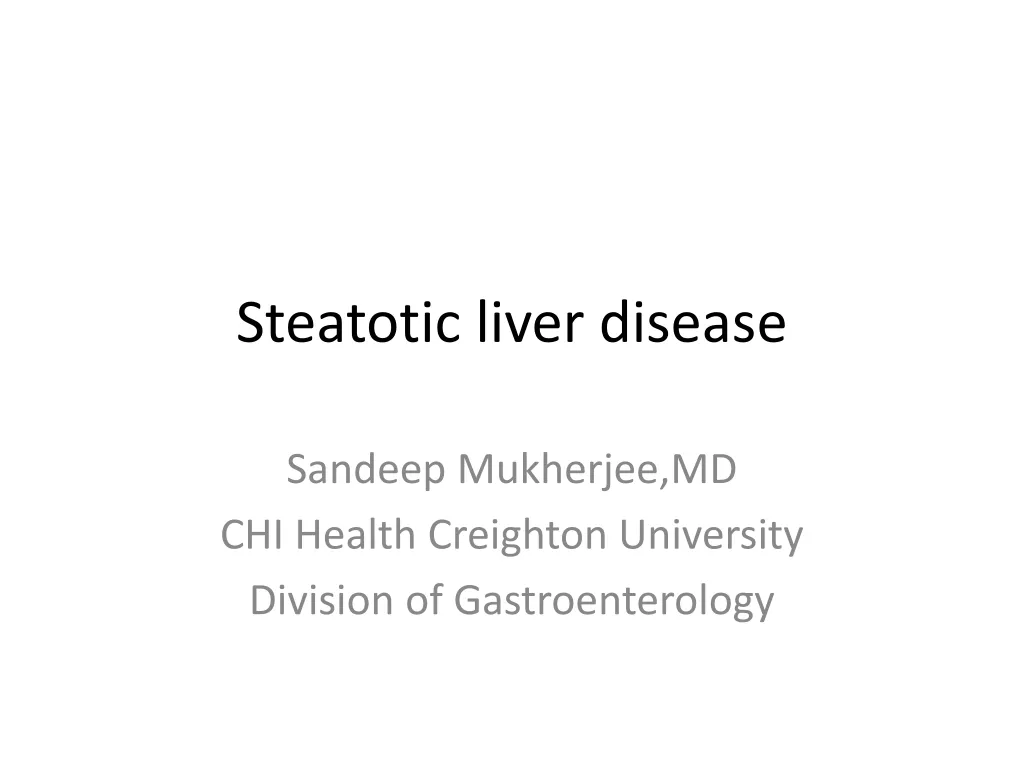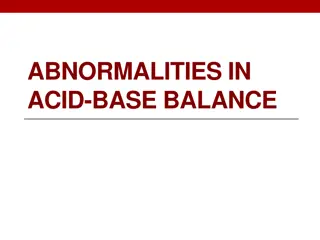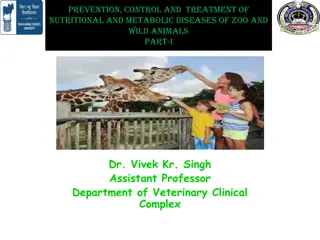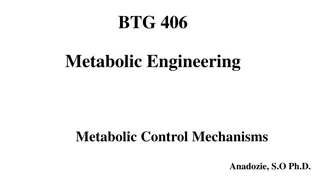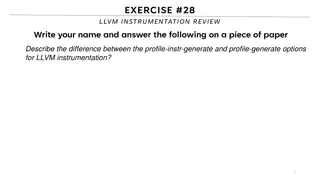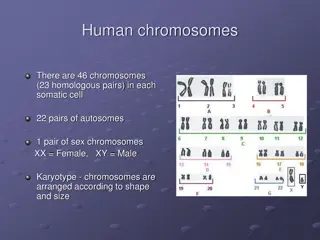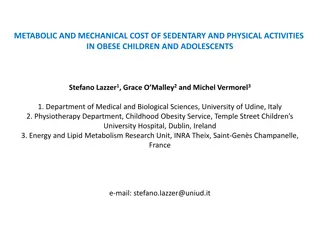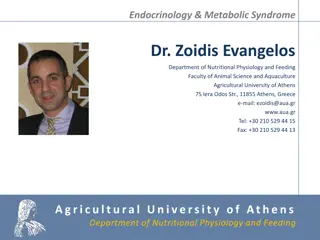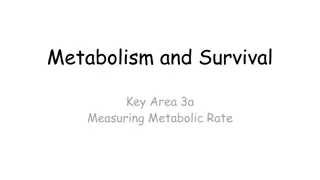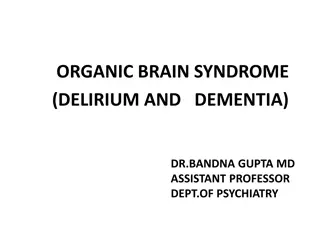Study of Metabolic Syndrome Profile in Gardinnage Company
Presented by Dr. Mandob Enyegue Damaris, this study explores the metabolic syndrome profile in a company associated with the University of Yaound. It delves into the various abnormalities related to carbohydrates, lipids, and vascular risk factors that contribute to diabetes type II and cardiovascular diseases. The research discusses the history, characteristics, diagnostic criteria, and prevalence of metabolic syndrome, shedding light on its impact on public health.
Download Presentation

Please find below an Image/Link to download the presentation.
The content on the website is provided AS IS for your information and personal use only. It may not be sold, licensed, or shared on other websites without obtaining consent from the author.If you encounter any issues during the download, it is possible that the publisher has removed the file from their server.
You are allowed to download the files provided on this website for personal or commercial use, subject to the condition that they are used lawfully. All files are the property of their respective owners.
The content on the website is provided AS IS for your information and personal use only. It may not be sold, licensed, or shared on other websites without obtaining consent from the author.
E N D
Presentation Transcript
Study of metabolic syndrome profil in gardinnage company of the university Of Yaound I presented by Dr. Mandob Enyegue Damaris
PLAN Introduction Material and Proceduris Results and Discussions Conclusion and perspectives
Introduction The metabolic syndrome is actually a major problem to public healt The theme metabolic syndrome refers to a group of abnormatities which can be carbohydrates, lipids and associated vascular risk factors that can lead to diabetes type II and cardiovascular diseases linked to atherosclerose in most individuals. The history of metabolic syndrome is illustrated by the evolution of it s name: Plurimetabalic syndrome, X syndrome, mortal quartor, insulino-resistant syndrome and dysmetabolic syndrome
Introduction It is characterised in an individual by the simultanous presence of the following factors: Obesity Dyslipidemia Arterial hypertension The high waistline Hyperglycemia Several studies have proven that individuals having all above characteristies are exposed to high cardiovascular abnormatities ( Empara and al.,2004)
Introduction There exist several definitions of metabolic syndrome which complicates a son diagnostic,proposed by international organisations and group of experts such as; OMS (1998 ) EGIR (1999) The NCEP-ATP III (2001) AACE (2001) AHA/NHLBI (2004) FID (2005) FID/AHA/NHLBI (2009) But those proposed by the NCEP are easily applicable clinically.
Introduction The definition of the NCEP does not any criteria Fasting blood sugar 6.1 mmol/L Arterial pressure 130/80 mmHg Dyslipidemia TG 1.7 mmol/L HDL 1mmol/L in men and 1.3 mmol/L in the women Klaist size 102 cm in men et 88 in woman
Introduction Studies show the prevalence of metabolic syndrome and a components varis ethnicity, dietany behaviors, physical activity,age,sex, the genetic difference(Cameron and al.,2004 The choice is between campus police base on their daily activities ( duration at work, stationang station to station,stress, the daily feeding etc.)
Introduction The mastery of risk factors associated wich metabolic syndrome , has brought us to set awselves the general objectives. The metabolic syndrome in individuals of the company baby sitting (garding) the university of yaound I Specific objectives : The prevalence of individual components of the metabolic syndrome, The prevalence of the metabolic syndrome, The characteristics of metabolic syndrome in the company
Material and procedures This study was sponsored by the Education and prevention of non communicable diseare programm of the medical foundation Andre Fouda and authoriced by the rector of the university of yaound I. The levy and biochimical examination were made by frained personnel of the medical foundation Andre Fouda Investigation: Interrogation; A survery sheet enabled us to identyfy the demographie data of patients.
Material and procedures Taking anthropometric measurements ; the following materials (equipments) permitted us to take the anthropometric measuerements . A measuring rod , which was used to measure the size; A weigh-person (balance), which was used to measure the weight; A meter tape , which measured the waist circumference; A sphygmomanometer, whivh was used to measure blood pressure
Material and procedures Blood sample and evaluated of biochimical parameters: Blood samples were leviel fasting by veripimeture on heparin; The test tubes with anticoagulant were used to collect the blood to dose (titrate) for glycimia; The test tubes withait anti-coagulant were used to collect the blood ta titrate (dose) for lipid parameters Plasma glycemia Serum lipid properties (parameters): TG, Chol-t, Chol-HDL
Material and procedures Statistical data analysis The qualitatives variables were expremed by their averaye +- standard deviation which the qualitatives were expremed by their percentage of the work force; The SPSS ( statistical package for social sciences) version 16.0 for window was used for the analysis of results; The significance level used was of 0.05
Results and discussion Individuals 53 in number responded favorable to the study Figure 1 : Turn out of particiption and non participation
Results and Discussion Figure 2: Distribution of population of study by sex of the person individual
RESULTS AND DISCUSSION The participetion rate of 51.96 % was obtained thanks to the agreement of the president who motivates participants and also the awareness that we had conducted with the chief of campus police. Nearly72 % of participation have a degree GCE E-Leve. However 48.04 % of the rate of non-participation of the fear of screening for STDS and also the degree of understanding based on the importance of the study of non-communicable diseases at high risk. We find that this population is in majority of human or 88.68 %. The met the natural conditions in the genre and are more physically. The low proportion of the woman 11.32 % is due to the lack of substantial recrutment of woman in this body metier (type of job). The security requires certain physical competence
RESULTS AND DISCUSSION Biographic and demographic characteristics T able I: Representation of biographical and demographical characteristics
RESULTS ET DISCUSSION The average of 26.38 +-4.7 25 BMI which corresponds to the maximum normal value and the cholesterol-HDL whose average is 40.07+- 25.69 characterizes the minimum threshold hypocholesterolemia. Other parameters values were within normal rangs The high rates of overweight, high blood pressure and HDL- hypocholesterolemia observed can be explained by the high alcohol consomption including energy promotes the storage of energy from food.
RESULTS AND DISCUSSION The overweight wchich will lead to obesity is also responsible for the genesis of dyslipidemia with results, by the decrease in HDL- cholesterol levels and observed non-dimination of total cholesterol. The HDL-cholesterol deficit causes an accumulation of total cholesterol in tissues with consequence the genesis of atherosclerosis which is the main determinant of VDC
RESULTS AND DISCUSSION Prevalence of metabolic syndrome and as individual components. Table II : Prevalence of metabolic syndrome and as individual companents
RESULTS AND DISCUSSION HDL-cholesterol (54.72 %) blood pressure (41.51%) and waist circumference (20.75%) are the most frequence individual components. Glycemia and fasting triglycerides are less frequent components witheach 3.77 %. Alcoholism and smoking are strongly associated to the occurrence of metabolic syndrome components (Tolstrup and al., 2006; Csiszar and al., 2009). Alcohol prevalence was high 100 % in people who consumed at least once a day , wich explains the high rate of hypercholesterolemia- HDL, blood pressure and waist circumference.
RESULTS AND DISCUSSION According to NCEP, to be a bearer of metabolic syndrome , one should have at least 3 of the 5 criterria that characterize the metabolic syndrome Table III : Evolution and sevrety of metabolic syndrome components
RESULTS AND DISCUSSION These various cardimetabolic risk factors helped determine the prevalence of metabolic syndrome in our study population. We got a low prevalence of metabolic syndrame in the rangs of 5.66 %. This low prevalence of the matabolic syndrome many be explained by the level of physical activity of the regular traning that has suffered this population . However 33.96 % of people are on the threshold of metabolic syndrome. This is explained in part by the presence of hypocholesterolemia and blood pressure elevation and partly by their physical activaty which improves insulin sensitivity ( Pater and al., 1995) and reduces some complications of obesity for example and therefore the aggregation of many components of metabolic syndrome in the population.
Conclusion In the course of this study whose general objective was : The metabolic syndrome in the individuals of the campus police . More specificly: The prevalence of the metabolic syndrome individual components; The prevalence of the metabolic syndrome; The characteristies of the metabolic syndrome. The prevalence of individual components such as blood glycose, HDL- Cholesterol, TG, hypertension were respectively 3.77 %, 54.72 %, 3.77 %, and 41.51 %. The prevalence of the metabolic syndrome among this company is 5.66 %
PERSPECTIVE AND RECOMMENDATION The evolution of CVD and stoke being very dynamic in Cameroun, we will extend our study to other gardinnage companus as DAK services, G4S etc and also in the army As a recommendation A change in lifestyle ( diet, physical activity, smoking and alcoholism) should be made; Daily physical activity of moderne intensity for at least 30 minutes.
